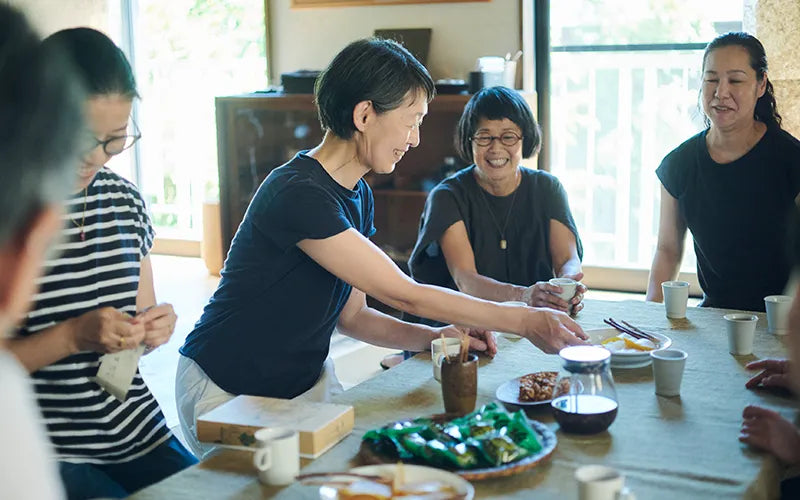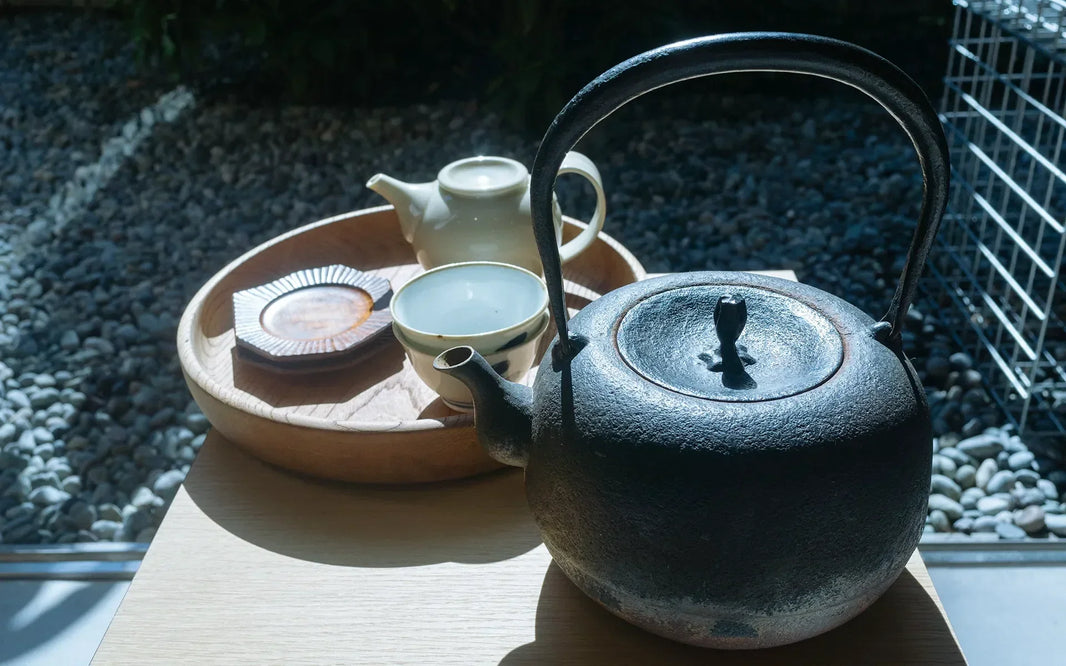On a personal note, I'm absolutely in love with tableware. While ten plates might be enough for a couple's dining needs, there's something about the colours, shapes, textures, sizes, and their unique presence that captivates me. Drawn to these charms, I kept buying pieces until, before I knew it, our cupboard had become a treasure chest filled with various expressions of craftsmanship that never fails to lift my spirits.
Recently, Nakagawa launched the "Kojitsu Chawan" (Good Day Rice Bowl) series, featuring rice bowls with various patterns from different regions. We hope this collection will help people enjoy the beauty of tableware beyond mere functionality at their dining tables.
Among tableware, rice bowls are particularly personal items, with many people using "just one bowl" or "not keeping multiple varieties." Many only replace their rice bowls when they break.
When I heard this from our designer, my curiosity was piqued. "I want to hear about other people's rice bowl stories!" This interest led us to organize a roundtable discussion with three tableware enthusiasts before the launch of the Kojitsu Chawan series.
Meet Our Participants:

Left: Yuki Sakai
Lives with spouse and two children. Owner of "Shichifuku Shokudo," a restaurant and café in Naramachi. Loves antiques and uses vintage tableware collected personally for serving set meals at the restaurant.
*Note: This roundtable was held at Shichifuku Shokudo*
Center: Shizuka Okada
Visual artist creating ceramic objects. Lives with her painter husband and three children. Usually uses antique ceramics at home, and during family trips, they visit historical kiln sites in regions like Hizen and Mino-Seto.
Right: Ayaka
Lives with her husband. Working as a culinary expert based in Nara under the title "Rice Enthusiast." Develops recipes for companies and runs popular cooking classes from home that quickly fill up.
How did your love for tableware begin?
Ayaka:
"I bought my first rice bowl when I started living alone in college. Initially, I got simple ones from the 100-yen shop. As I began enjoying hosting people and cooking for them, I wanted to serve food beautifully and excitingly. That's when it started. While working part-time jobs, I gradually collected pieces. Though it began with wanting to please others, now I find joy in using them myself every time I eat."

Okada:
"For me, it was after marriage. While I enjoyed looking at tableware during my single life, I didn't cook much, so having tableware didn't feel relevant. My passion really ignited after marriage when my husband became interested in Japanese antique ceramics after we returned from living abroad. We started with just a few artist pieces, but one day we wanted soba noodles. Looking for soba cups led us to discover various patterns, and though we only needed two, we kept collecting beautiful ones.
Soba cups are versatile - you can use them for side dishes or sake. Though neither of us drinks much, there was a period when we deliberately had sake just to use our growing collection of cups (laughs).
Now we have various pieces, and the children each have their favorite patterns. At mealtimes, they pick from the cupboard based on their mood. While I have to veto some choices, I let them enjoy using sturdy pieces they've chosen themselves. My 6-year-old loves blue and white pottery, while my 4-year-old prefers iron glazes and unique patterns. Everyone has different tastes."

Sakai:
"Like Ayaka, it started in college. When I began living alone in Nara, I mostly used dishes from my parents' home since I had various expenses. You know, those promotional plates you get from bread companies (laughs). They were truly convenient and unbreakable.
As I got used to daily life, I started paying more attention to cooking, which naturally led to an interest in tableware. I love antique pieces, and my first purchase was a mug from a folk craft museum shop. An acquaintance who loves vintage clothing once said, 'With vintage clothes, you can wear the creator's philosophy,' and I realized the joy of using things I love daily.
After that first purchase, I became interested in various pieces and started collecting rice bowls and plates from antique markets and favorite artists' exhibitions. But I still have those promotional plates. I like seeing my cupboard with all these pieces that have helped me along the way - it really feels like life."

Ayaka:
"I totally understand. I still have my 100-yen shop dishes too. They're really practical, especially for microwave heating. I can't bring myself to throw them away. It's not about being cheap - each piece has its own merit."
How has your selection process changed from when you started to now?
Sakai:
"Initially, I bought pieces that caught my eye individually, but as my collection grew, I started thinking about how they'd work together. If you only buy striking pieces, they might not harmonize on the table."
Okada:
"We still buy primarily based on loving individual pieces rather than coordination. While we sometimes consider combinations, we mostly choose impulsively (laughs). However, our family's changing shape has gradually shifted what sizes work for us.
For instance, after our family grew, we started using large plates more often. Even on days when cooking elaborate meals feels challenging, a beautiful large plate makes everything special. When I realized that tableware could make the table look good even with simple cooking, I've been relying on that magic ever since.
Tableware has become a family conversation topic too. We often chat about the patterns on the table, which has become a family pleasure."

Ayaka:
"That family conversation about tableware sounds wonderful! Like Sakai-san, I initially chose pieces based on instant attraction - if I found it, I bought it! Now, I imagine how it would pair with food. I have a rule: 'Don't buy unless I can think of at least three dishes to serve in it.'
This came from early experiences where some pieces I loved ended up being impractical and rarely used. That felt sad. I believe tableware gains value through use, so even if a piece sparkles in the shop, I prioritize how it will function on my table and whether I can truly cherish it."
What rice bowls do you use daily? Tell us about your personal bowl situations.
Okada:
"About 90% of our pieces are antiques since we love old items. While the children use the same soup bowls and large plates as adults, for rice bowls, we also use some from major retailers for practicality. In terms of numbers, my husband keeps buying them, so we have around 20 rice bowls alone - quite a collection (laughs).
In our home, no one has a designated bowl - the children and I choose what feels right each day."

Sakai:
"It's lovely that you can choose based on daily mood since childhood. Our family has two adults, one small child, and a baby, with five rice bowls including gifts. Some we bought as pairs, others individually based on personal preference.
Unlike Okada-san's family, we each have our designated bowl that we use almost daily. We only use others when the regular ones haven't been washed yet (laughs). I use a wooden gōroku bowl, which I absolutely love. I want to use it until the lacquer wears off completely. It's quite large, good for both rice and soup. That's my daily bowl.
Earlier I mentioned considering coordination when buying tableware, but this wooden bowl was a 'this is it!' moment. I was drawn to the wood texture and how it ages. It actually stands out completely at the table and doesn't match anything else (laughs)."

Ayaka:
"I have three pairs in cream, white, and black, six bowls total. While I love distinctive pieces for large plates, I find simple rice bowls more practical. I choose which to use based on the colors of other dishes on the table for balance.
I actually have another rice bowl with a rough, greenish, unique style, but rice didn't taste as good in it. That's when I realized different bowls can affect how rice tastes. I still love the pattern, so now it serves as a chopstick rest holder in the cupboard."

Why choose handcrafted tableware?
Okada:
"There's a different aura, a presence they emit. Of course, sometimes we prioritize functionality. When children bang dishes around, worrying about precious pieces can make meals less enjoyable. So we use different pieces flexibly depending on the situation.
Just yesterday, my eldest son actually 'graduated' from his long-serving department store rice bowl. While we'd been using easily manageable bowls for the children, he saw his father's bowl and said, 'I want to try using one like that.' Perhaps children are naturally drawn to that unique charm."

Ayaka:
"Handcrafted pieces have... how should I say it... a richness to them. They significantly elevate our thrice-daily meals, and that's why I choose handmade pieces. The happiness level is truly different."
Sakai:
"I actually use quite a few mass-produced pieces both at home and in the restaurant, mainly for their stability, consistency, and ease of use. I think we need those too. Their presence helps us appreciate handcrafted pieces more.
I use handcrafted pieces because of the scenery they create. Rice bowls especially are daily items. Every time I see them at the table, they remind me of when I bought them and their historical context, making them increasingly precious. I think handcrafted pieces carry these elements more readily than mass-produced ones."

Which Kojitsu Chawan would you choose for yourself?


Sakai:
"I'd choose the 'Gosu Komassuji' (Cobalt Spinning Top Lines). The impression seems like it would coordinate well with my antique pieces. And simply put, I love the pattern. Just having rice in this bowl with miso soup would really lift my spirits."


Okada:
"The 'Ameshiro Gōshi' (Honey White Checkered) for me. White rice would look delicious in it, and it seems deep enough for soup too. My children love natto rice, and deeper bowls make mixing easier, so it seems practical for both adults and children. Among pottery regions, I particularly love Onta-yaki, and this bowl's warm color would complement those pieces nicely."

"I also love the 'Sabi Shiro Shika' (Rustic White Deer) for its cuteness. I was moved by learning that deer have traditionally symbolized good fortune because 'roku' (deer) shares pronunciation with 'blessing from heaven.' The dining table is also a learning space for children, so beyond cute patterns, discussing the meaning behind designs can create lasting memories."


Ayaka:
"I choose the 'Annan Karakusa' (Annam Arabesque). I love its subtle color that catches the eye without being too dark. And simply put, it seems versatile. Beyond rice, it could work for soup or chawanmushi steamed custard. It would complement both Japanese and ethnic cuisine - I can imagine it looking great with soup topped with cilantro. This bowl most stimulates my culinary imagination."


This roundtable discussion really highlighted tableware's charm beyond mere functionality - how it can soothe and excite our hearts as reliable companions in daily life.
It's fine to stick with your favorites or switch based on daily moods. The same applies to rice bowls. I hope our days can be more enjoyable with tableware we cherish.
We'd be delighted if the new Kojitsu Chawan series becomes a wonderful partner in creating such joyful dining tables.

Text: Junko Tanijiri
Photos: Haruhi Okuyama







